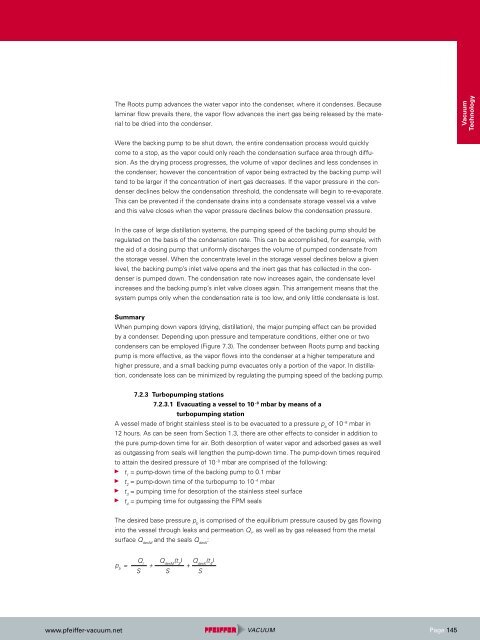You also want an ePaper? Increase the reach of your titles
YUMPU automatically turns print PDFs into web optimized ePapers that Google loves.
www.pfeiffer-vacuum.net<br />
The Roots pump advances the water vapor into the condenser, where it condenses. Because<br />
laminar flow prevails there, the vapor flow advances the inert gas being released by the material<br />
to be dried into the condenser.<br />
Were the backing pump to be shut down, the entire condensation process would quickly<br />
come to a stop, as the vapor could only reach the condensation surface area through diffusion.<br />
As the drying process progresses, the volume of vapor declines and less condenses in<br />
the condenser; however the concentration of vapor being extracted by the backing pump will<br />
tend to be larger if the concentration of inert gas decreases. If the vapor pressure in the condenser<br />
declines below the condensation threshold, the condensate will begin to re-evaporate.<br />
This can be prevented if the condensate drains into a condensate storage vessel via a valve<br />
and this valve closes when the vapor pressure declines below the condensation pressure.<br />
In the case of large distillation systems, the pumping speed of the backing pump should be<br />
regulated on the basis of the condensation rate. This can be accomplished, for example, with<br />
the aid of a dosing pump that uniformly discharges the volume of pumped condensate from<br />
the storage vessel. When the concentrate level in the storage vessel declines below a given<br />
level, the backing pump’s inlet valve opens and the inert gas that has collected in the condenser<br />
is pumped down. The condensation rate now increases again, the condensate level<br />
increases and the backing pump’s inlet valve closes again. This arrangement means that the<br />
system pumps only when the condensation rate is too low, and only little condensate is lost.<br />
Summary<br />
When pumping down vapors (drying, distillation), the major pumping effect can be provided<br />
by a condenser. Depending upon pressure and temperature conditions, either one or two<br />
condensers can be employed (Figure 7.3). The condenser between Roots pump and backing<br />
pump is more effective, as the vapor flows into the condenser at a higher temperature and<br />
higher pressure, and a small backing pump evacuates only a portion of the vapor. In distillation,<br />
condensate loss can be minimized by regulating the pumping speed of the backing pump.<br />
7.2.3 Turbopumping stations<br />
7.2.3.1 Evacuating a vessel to 10 - 8 mbar by means of a<br />
turbopumping station<br />
A vessel made of bright stainless steel is to be evacuated to a pressure p b of 10 - 8 mbar in<br />
12 hours. As can be seen from Section 1.3, there are other effects to consider in addition to<br />
the pure pump-down time for air. Both desorption of water vapor and adsorbed gases as well<br />
as outgassing from seals will lengthen the pump-down time. The pump-down times required<br />
to attain the desired pressure of 10 - 8 mbar are comprised of the following:<br />
t 1 = pump-down time of the backing pump to 0.1 mbar<br />
t 2 = pump-down time of the turbopump to 10 - 4 mbar<br />
t 3 = pumping time for desorption of the stainless steel surface<br />
t 4 = pumping time for outgassing the FPM seals<br />
The desired base pressure p b is comprised of the equilibrium pressure caused by gas flowing<br />
into the vessel through leaks and permeation Q l , as well as by gas released from the metal<br />
surface Q desM and the seals Q desK :<br />
Q l Q desM (t 3 ) Q desK (t 4 )<br />
p b = + +<br />
S S S<br />
Page 145<br />
<strong>Vacuum</strong><br />
<strong>Technology</strong>

















